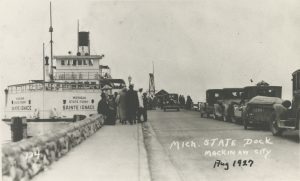
The summer of 2023 marked the 100th anniversary of the Michigan State Highway ferry service going into operation. The service was started to get automobiles and their drivers across the Straits of Mackinac in a timely fashion. Prior to the service being instituted, the Mackinac Transportation Company and their two railroad car ferries, Chief Wawatam and Sainte Marie carried automobiles across when possible. In 1917 when the first automobiles were taken across, it cost $40 and the car had to be loaded on a railway flat car. On top of that, the automobile had to be drained of gasoline due to maritime regulations. By the early 1920’s, several drivers had complained to Governor Alex Groesbeck, who asked legislators to approve a state-run ferry.
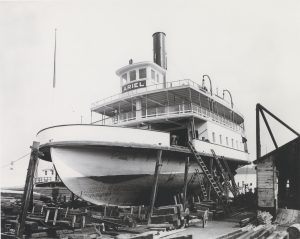
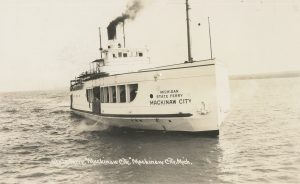
The first ship purchased by the state was the Ariel which could haul 20 automobiles. On August 6, 1923, she made her first trip and by November when the season ended she had carried around 10,000 cars. The highway department purchased two more vessels that year, the Colonel Pond and Colonel Card which became the Sainte Ignace and Mackinaw City. Along with the purchase of ships, the state bought a dock in St. Ignace and adapted part of the railroad dock in Mackinaw City to load and unload the cars. By 1925, the state had purchased shoreline property in Mackinaw City and had a 1,400-foot causeway built. The state ordered its first ferry in 1927 and it was christened, The Straits of Mackinac, which could carry 50 cars.
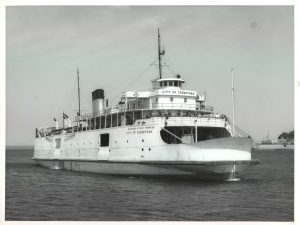
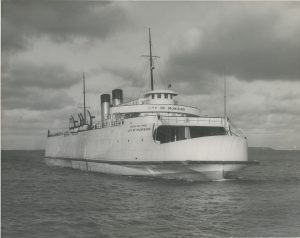
During the 1930’s, the highway department improved the docks on both sides of the straits by making them bigger for the increasing demand in auto traffic. Restrooms, large parking lots for waiting motorists and elevators for lifting cars to the second deck of the ferries were constructed. More ferries were added to the fleet; instead of building new ships, unused Lake Michigan railroad ferries were acquired. The first was the Ann Arbor No. 4 which became the City of Cheboygan in 1937. One year later the Pere Marquette No. 20 was purchased and became the City of Munising. Rounding out the decade was the addition of the Pere Marquette No. 17 which became the City of Petoskey in 1940.
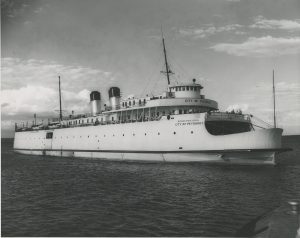
Rationing of gasoline and tires during World War II saw most of the ferries sitting idle but the post-war saw an increase in crossings. Three of the ships were altered by adding seagates to the bow allowing for faster loading and unloading. In 1948, the ferry service celebrated its 25th anniversary with several events including a parade, coronation ball, swimming race to Mackinac Island and a special moonlight cruise aboard The Straits of Mackinac. One of the highlights was models of the new icebreaking ferry the state proposed to build. One year later, construction began on the 360-foot-long, diesel-powered Vacationland. The ship had pilothouses and double propellors on both ends and could carry 150 automobiles.
The Vacationland arrived in St. Ignace January 12, 1952 and immediately began hauling cars across. Due to her size and power plant, new slips were constructed in St. Ignace and Mackinaw City along with storage tanks to supply the ship with diesel and lubricating oil. As the ship began her service, plans were underway to construction a new way to cross the straits. In 1954, funds were obtained to start construction of the Mackinac Bridge which was completed in 1957. One of the stipulations of construction was that the highway ferries would stop running the day the bridge opened. The ferries were eventually sold, the City of Cheboygan and City of Munising being used to store and ship potatoes from Washington Island, Wisconsin. The City of Petoskey was sold for scrap and The Straits of Mackinac ferried tourists to Mackinac Island. She was the last surviving ferry eventually being sunk as a dive site off Chicago in 2005.
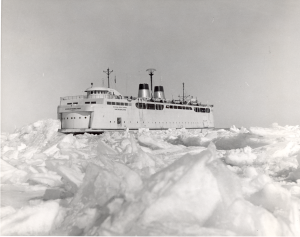
The Vacationland was sold and renamed Jack Dalton hauling trucks between Detroit and Cleveland. The venture lasted only a few months and the state repossessed the ship after failed payments. The vessel was sold again to North-South Navigation Company in 1961 and renamed Pere Nouvel. She returned to her role as an automobile ferry crossing the St. Lawrence River between Rimouski and Baie Comeau, Quebec. In 1967, she sailed to the West Coast of Canada serving British Columbia as the Sunshine Coast Queen until 1977. After an attempt to make her an oil drilling support ship on Alaska’s North Slope, she was sold to a company in Washington for scrap. She was to be towed to China but on December 3, 1987, the tow ran into an early winter storm and the ship began to take on water. The ship sank in the Pacific Ocean about 100 miles offshore in deep water with no loss of life.









